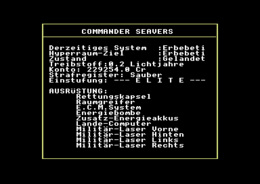Elite
| This article describes the computer game Elite. For other uses, see Elite (Disambiguation) |
| Elite | ||
|---|---|---|
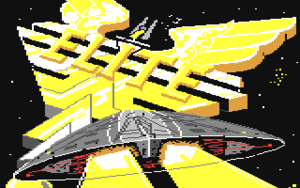 | ||
| Game No. | 243 | |
| Voting | 8.61 points, 76 votes | |
| Developer | David Braben, Ian Bell, Aidan Bell | |
| Publisher | Firebird, Ariolasoft GmbH | |
| Musician | David Dunn (coding), Aidan Bell (composition),[1] Johann Strauss (composition) | |
| HVSC-File | MUSICIANS/D/Dunn_David/Elite.sid | |
| Release | 1985 | |
| Platform | Acorn Archimedes, Acorn Electron, Amiga, Apple II, Atari ST, BBC Micro, C64, NES, Amstrad CPC, MSX, ZX Spectrum, Tatung Einstein, MS-DOS Unoffical: Plus/4 C128 | |
| Genre | Simulation, Space | |
| Gamemode | Single player | |
| Operation | ||
| Media | ||
| Language | ||
| Information | Successor: Frontier: Elite II (1993, not converted to 8-bit systems) | |
Description[edit | edit source]
The game Elite has no defined aim and no defined ending. There is no time limit, in which certain tasks need to be done. This open game principle differs basically from all computer games known at this point of time.
As Commander Jameson the player can travel through eight galaxies to boost his career as an astronaut. The success of the player becomes noticeable both in cash money and the grading as astronaut. Large and small mistakes have an influence on the criminal record, which in turn can result in a more hostile behaviour of the authorities or other astronauts. The player's spaceship needs to be navigated through three-dimensional space. The player can control the speed and the rotation around the crosshair and the vertical axis. Unlike Elite 1, the flying characteristics are like flying through the air (not a vacuum) – the maximum speed is reached quickly and a relatively narrow spiralling is possible. Furthermore, the gravitational force of the celestial bodies is missing - one has to steer around planets instead of swivelling into an orbit. The space traffic is handled by orbital stations; landing on a planet is not possible (for the player). Strangely, there is exactly one planet in each solar system with each exactly one orbital station. Docking to them can sometimes prove to be difficult. Interstellar distances are crossed by hyperspace jump of at most 7 light years.
The beginning spaceship is equipped only very basically and the capital is very limited. Additional equipment can be bought which improves the fighting power and the possibilities to earn money significantly. Other spaceships cannot be bought.
The possibilities to earn money are manifold. On the one hand you can trade by using the price differences between two solar systems. The prices of the traded goods are random to a small extent and mainly dependent on the economic classification of the corresponding system. With a space claw you can retrieve unowned items from space, which then can be sold. If the player does not want to wait until other spaceships jettison their shipping containers voluntarily, he can help them a bit by shooting the laser. This procedure is usually referred to as piracy. For shooting pirate ships and asteroids you usually get paid a small award, a bounty. Another source of income is the mining industry, which is the decomposing of asteroids with the mining laser. The parts can be collected and sold.
A special peril pose the Thargoid Invaders. They can pull spaceships from their hyperspace jump and attack them in interstellar space. The octagonal ships of the Thargoids are astonishingly strong and robust. Furthermore, these spaceships send out remote-controlled drones that can be caught and sold. Sometimes these Thargoid ships also appear in space close to planets.
As a special goody the player is also offered in this game version altogether three missions:
- If the account has reached 6583,5 Cr for the first time, the player can buy "Trumbels". This is actually not really a mission but it poses a task for the player.
- After 256 kills and in the first and second galaxy the player gets offered to search the stolen prototype of a fighting ship and destroy it. As a reward beckon 5000 Cr.
- After finishing the previous mission and 1280 kills and the third galaxy the player is offered to transport blueprints for a new fighting ship through half the galaxy. Here you are awaited by numerous fights with Thargoids as well as an improved energy unit as a reward.
Design[edit | edit source]
The game Elite has the following design features:
- 3D-simulation in vector graphics; objects are displayed as lattice model (unique at that time on the C64).
- View in first-person perspective from the cockpit of a spaceship, information screens for the trading and navigation functions. Various sound effects and two music pieces.
The functional position screen in the lower part of the screen shows the position of other objects relative to the own spaceship in Cartesian view.
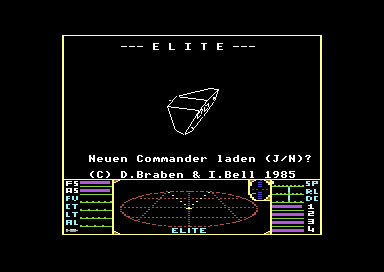
Hints[edit | edit source]
Controls[edit | edit source]
- 1 buy load (only when ship is docked)
- 2 sell load (only when ship is docked, otherwise overview of good prices)
- 3 equip ship (only when ship is docked)
- 4 galactic map
- 5 local map
- 6 data about the system
- 7 market prices
- 8 status
- 9 inventory
- F search planet (only when star map is called up)
- D distance to the system (star map)
- O set back cursor to current position (star map)
- @ access to storage medium (only when ship is docked)
- # leave trade menu (see 1,2,3)
- Inst/Del ← (arrow to the left key) restart game
Ensure Joystick is in Port 2. If it's in Port 1, the result will be confusing, because "Joystick left" will fire the laser and none of the other directions will work.
- , or < roll anti-clockwise or JOYSTICK
- . or > roll clockwise or JOYSTICK
- S sink or JOYSTICK
- X rise or JOYSTICK
- Space more thrust
- - or /? less thrust
- C switch on docking computer
- P switch off docking computer
- H hyperspace jump
- J short jump
- CTRL H galactic hyperspace jump
- A fire laser or FIRE BUTTON
- T place missile on aim
- M fire missile
- U deactivate missile
- E activate ECM-System (if available)
- C= (Commodore key) energy bomb
- ← activate emergency capsule (if available)
- F1 view to the front (start)
- F3 view aft (start)
- F5 view startboard (start)
- F7 view portside (start)
In the English version there is only one music piece (by Johann Strauß). In the German version, however, there is an additional song. When you have stopped the game with "Inst/Del", there are the following undocumented functions.
- A switch alignment (during rolling/tilting) on/off
- Run/Stop switch absorbability on/off
- K keyboard/joystick controls
- Y swap left/right (aim backwards)
- J swap left/right and up/down
- Q sound effects OFF
- S sound effects ON
- F flashing RED/YELLOW ON/OFF
- P drawing of planet
- C music possible/not possible
- M switch music immediately on/off
- B switch on/off sounds during music
- E choose between two songs
- X switch mode on/off: CTRL during hyperjump "attracts" Thargoids.
Spaceship types[edit | edit source]
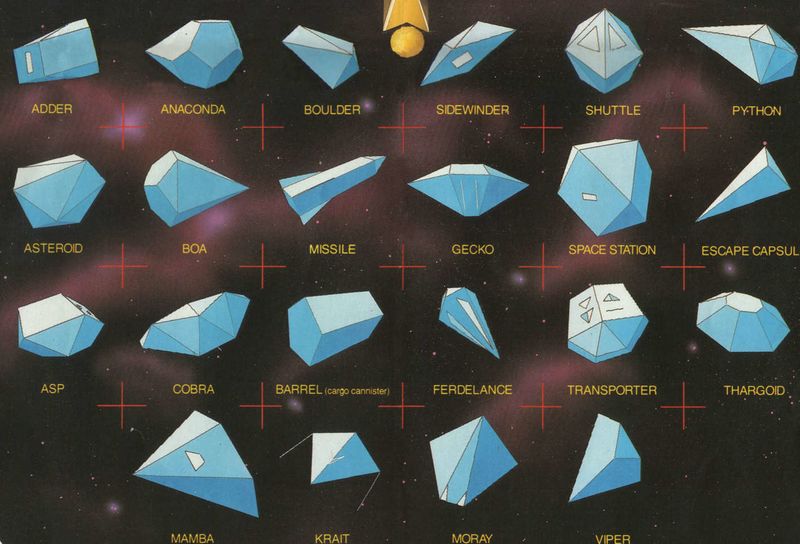
Kills/Ranking[edit | edit source]
| Kills | Ranking |
|---|---|
| 0 | Harmless |
| 8 | Mostly Harmless |
| 16 | Poor |
| 32 | Average |
| 64 | Above Average |
| 128 | Competent |
| 512 | Dangerous |
| 2560 | Deadly |
| 6400 | Elite |
(Source: http://www.iancgbell.clara.net/elite/faq.htm#A4 )
Ship specs and kill evaluations[edit | edit source]
In the BBC version each ship is counted as a kill. In the C64 version a "fractional" byte (a so-called kill evaluation) was inserted, which is incremented by approximately one-third the value given in the column "Kill Value" in the following table (multiplied by 256). For example, a Krait will increment the fractional byte by 85 and a Police Viper will increment it by 26, so you will need to kill approximately 3 Kraits or 10 Police Vipers to earn 1 "kill".
| Name | Size | Energy | Speed | max.miss. | max.loot | Bounty (CR) | Kill Value | |
|---|---|---|---|---|---|---|---|---|
| Coriolis Stn. | 160 | 240 | 0 | 6m | 0t | 0 | 0 | |
| Dodec Station | 180 | 240 | 0 | 0m | 0t | 0 | 0 | |
| Missile | 40 | 2 | 44 | 0m | 0t | 0 | 1.75 | |
| Tharglet | 40 | 20 | 30 | 0m | 0t | 5 | 0.3906 | |
| Space Junk | 16 | 17 | 8 | 0m | 0t | 0 | 0.1953 | |
| Escape Capsule | 16 | 17 | 8 | 0m | 0t | 0 | 0.1953 | |
| Platelet | 10 | 16 | 16 | 0m | 0t | 0 | 0.125 | |
| Cargo Cannister | 20 | 17 | 15 | 0m | 0t | 0 | 0.1211 | |
| Boulder | 30 | 20 | 30 | 0m | 0t | 0.1 | 0.0781 | |
| Astroid | 80 | 60 | 30 | 0m | 0t | 0.5 | 0.0977 | |
| Rock Splinter | 16 | 20 | 10 | 0m | 0t | 0 | 0.1172 | |
| Shuttle | 50 | 32 | 8 | 0m | 15t | 0 | 0.1953 | |
| Transporter | 50 | 32 | 10 | 0m | 0t | 0 | 0.1992 | |
| Rock Hermit | 80 | 180 | 30 | 2m | 7t | 0 | 1 | |
| Police Viper | 75 | 140 | 32 | 1m | 0t | 0 | 0.3125 | |
| Traders | ||||||||
| Cobra III | 95 | 150 | 28 | 3m | 3t | 0 | 2.75 | |
| Python | 80 | 250 | 20 | 3m | 5t | 0 | 2 | |
| Boa | 70 | 250 | 24 | 4m | 5t | 0 | 2.5 | |
| Anaconda | 100 | 252 | 14 | 7m | 7t | 0 | 3 | |
| Pack Hunters | ||||||||
| Sidewinder | 65 | 70 | 37 | 0m | 0t | 5 | 1 | |
| Mamba | 70 | 90 | 30 | 2m | 1t | 15 | 1.5 | |
| Krait | 60 | 80 | 30 | 0m | 1t | 10 | 1 | |
| Adder | 50 | 85 | 24 | 0m | 0t | 4 | 1.0625 | |
| Gecko | 99 | 70 | 30 | 0m | 0t | 5.5 | 1 | |
| Cobra I | 99 | 90 | 26 | 2m | 3t | 7.5 | 2 | |
| Worm | 99 | 30 | 23 | 0m | 0t | 0 | 0.5859 | |
| Lone Wolves | ||||||||
| Cobra III | 95 | 150 | 28 | 2m | 1t | 17.5 | 3.5 | |
| Asp II | 60 | 150 | 40 | 1m | 0t | 20 | 3.25 | |
| Python | 80 | 250 | 20 | 3m | 2t | 20 | 3.5 | |
| Fer de Lance | 40 | 160 | 30 | 2m | 0t | 0 | 3.75 | |
| Moray | 30 | 100 | 25 | 0m | 1t | 5 | 2.25 | |
| Thargoid | 99 | 240 | 39 | 6m | 0t | 50 | 8 | |
| Constrictor | 65 | 252 | 36 | 4m | 3t | 0 | 16 | |
| Cougar | 70 | 252 | 40 | 4m | 3t | 0 | 16 | |
(Source: http://www.iancgbell.clara.net/elite/faq.htm#A4 )
(Kill Values converted to decimal by HtW)
Ship expansions[edit | edit source]
| Name | Tech-Level | Credits |
|---|---|---|
| Fuel | 1 | LY*2 |
| Missile | 1 | 30 |
| Cargo Bay Expansion | 1 | 400 |
| E.C.M. System | 2 | 600 |
| Pulse Laser | 3 | 400 |
| Beam Laser | 4 | 1000 |
| Fuel/Cargo Scoops | 5 | 525 |
| Escape Pod | 6 | 1000 |
| Energy Bomb | 7 | 900 |
| Extra Energy Unit | 8 | 1500 |
| Docking Computers | 10 | 1500 |
| Galactic Hyperdrive | 11 | 5000 |
| Mining Laser | 11 | 800 |
| Military Laser | 11 | 6000 |
Further hints[edit | edit source]
- The possible enemies in a fight usually use the same tactics which are dependent on the ship type. Especially the smaller ships try to stay in the blind angle, here additional lasers can be helpful.
- If three or more ships materialise at the same time close to each other in the planet-near space, these are almost always pirates.
- Thargoids in the interstellar space always appear in groups of four, in planet-near space a group of two always materializes and always in a backmost quadrant of the positioning screen.
- The octagonal ships of the Thargoids are damaged by using an energy bomb, but they usually do not get destroyed, the drones are fortunately less robust. Missiles are useless, as the Thargoids have an ECM- system and they can release this almost immediately after locating the missile.
- If activated drones of the Thargoids are destroyed or caught with the help of the space claw, the corresponding (octagonal) spaceship releases new drones. If all main ships are destroyed, the remaining drones are automatically deactivated.
- Thargoids are best defeated by immediately going to full speed and trying to destroy the largest group first. After doing so, or after reaching the first group, immediately decelerate almost to a stop. This reduces the turning radius of your ship. The most dangerous situation is when three Thargoids are in one group and you choose to attach another group first! You can usually discern the largest group using the scanner with some practice. See https://www.youtube.com/watch?v=ciAR-Gde6G0&t=11s.
- The regular use of missiles or energy bombs is a very expensive affair, as the costs for a missile are disproportionate to a possible reward. Both can be seen as a kind of life insurance. If a missile is shot from a striking distance, the victim may not have enough time to release its potentially available ECM system, which sometimes also works for Thargoid motherships.
- The own ship can survive a collision with another spaceship or a missile hit, if the shields have their full capacity. So it can make sense to simply ram an especially persistent small enemy (e.g. Adder, Worm) , before it fires its missiles.
- A good strategy in general for all encounters except Thargoids is to keep speed very low, to give you the most time to destroy enemies at a distance (while they are still displayed as dots). With practice, very few encounters will end with a "dogfight", even when carrying illegal goods or in Anarchy worlds.
- The numerous sound effects offer a precious help during a fight. A laser hit makes a different sound as a misfired shot. The missile system can be used as targeting help. Once activated a short peeping sound rings when a target is in the sight; this is the right moment to use the laser.
- Laser and ECM system use energy from the accumulators. When the energy is scarce you should abstain from the use of these appliances, so that at least one energy accumulator can regenerate. Course changes at random and braking and accelerating manoeuvres can avoid hostile hits in the meantime.
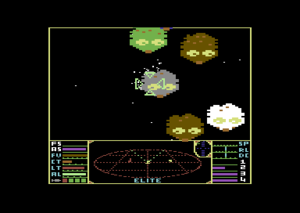
- Trumbels are only looking for trouble! But they are soooo cute! Staying near the sun kills them but it wlll be difficult to get the invested 5000 Cr back by selling the furs. Using an emergency capsule is also no help here!
- The stolen prototype "Constrictor" (2nd mission) can be found in a certain system. Hints in the planet data lead to the trail. Fortunately, the new owners have no idea what is in the ship.
- The transport of the blueprints (3rd mission) will not get boring at all.
- Nobody ever gained wealth through mining. The most useful application of a mining laser is the working on the outer skin of a bigger freight ship, which after some shots releases its load and disintegrates into debris that can be retrieved and sold together with the freight containers.
- Dealing with drugs, fire weapons or slaves leads to the grade "offender" in the criminal records.
- If an emergency capsule is retrieved, it can be sold - together with the creature inside it - as "slaves".
- If an orbital station is "accidentally" shot, this leads to a grade as "fugitive", and the fanning out of police ships. Here the player can only land again (if he can escape the police attacks), if the criminal record has been reduced (by a hyperspace jump) to "offender".
- The most trading profits can be reached, if you trade with systems that are as different as possible. You can reach good sales prices mainly with products that are rare in the corresponding system. Computer, machines and luxury goods sell in agrarian states significantly better than resources of all types, textiles or food.
- Gold, platinum and jewels can still be loaded although the cargo hold is already full. Captured drones of the Thargoids are attached at the outside of the ship and therefore do not add to the ships capacity.
Bugs[edit | edit source]
If a lot of goods has more than 6553,5 Cr, there is an undetected overflow and a lot less is calculated. If the value of the goods is 6554 Cr only 0,4 Cr are booked, unfortunately. So when selling you need to take care to sell in small amounts, then there are no problems! I noticed this when I wanted to sell 151kg of platinum for the hell of a price of 77,2 Cr. My 21.094,9 Cr became only 26.198,5 Cr after the sale, but it should become 32.752,1 Cr! So 6553,6 Cr were missing, this number was familiar to me, 65536 is 2 16,so 2 Bytes + 1. Greetings, Worf (Hints from the 64Games-Forum from 24.02.2004)
In the English version the first page of a two-sided information screen is always shown only for a few seconds , then immediately the second page is called up. This applies mainly to the system information and is therefore especially annoying, as the information about the economic system and the type of government are on the first page, the more meaningless additional information (made out of text modules) on the second page. In the German version this bug is fixed.
Manual docking (short course by Worf)[edit | edit source]
The docking is easiest, if you fly directly towards the station as in image 1,
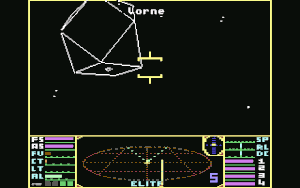
stop shortly before it and then align yourself to the planet as in image 2
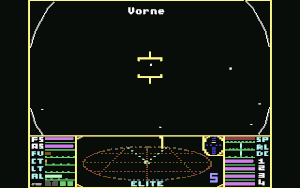
and then fly towards it with fulll speed for about seven seconds, at the same time do not disregard the height indication. During this you can well look out to the rear and watch the stations getting smaller.
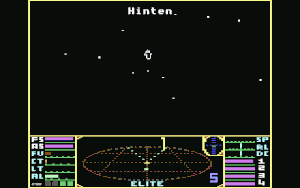
Then you stop again, turn and head for the station, are aligned perfectly, only co-rotate and fly in. If it does not work the first time, just repeat.
(Worf, 27.02.2004 in the C64Games Forum)
Automatic docking[edit | edit source]
The docking computer can land automatically, but makes correction of the course until the ship is on the ideal inbound track. As the ship is only accelerated to half the speed, the docking with the computer can take incredibly long.
The docking computer should in no case get switched on, if the station is not yet in sight, as the computer always chooses the direct path and does not consider whether other ships or the planet are in this path.
The player flies towards the station, stops shortly before it and then heads towards the planet. Then you fly a few seconds with full speed towards the planet. Then the ship has to turn instantly at a halt. The ship should now be already on a more or less convenient inbound track. With full speed it keeps heading for the opening now and at the last moment before the collision the docking computer is switched on.
Landing is most of the time a bit ungentle, but succeeds almost always. If the approaching angle was chosen really very unfavourable it can happen that the docking computer cannot make any sufficient corrections any more.
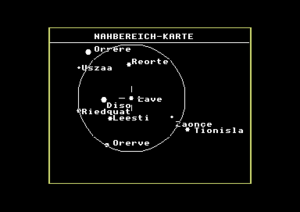
Manual[edit | edit source]
A complete manual including the novel "Das Dunkle Rad" to the game in ![]() is availabe online on C64Games.de - Game No. 594 . Additionally, you find there star maps of all galaxies, solutions and background knowledge about the missions and the game.
is availabe online on C64Games.de - Game No. 594 . Additionally, you find there star maps of all galaxies, solutions and background knowledge about the missions and the game.
Solution[edit | edit source]
Trade routes[edit | edit source]
For a start you should transport food from Lave to Leesti. After having sold the food completely, you fill your storage room with computers and bring them to the space station of Diso. From Diso you then fly again with food and later also with fissible material, spirits or furs back to Leesti to start from there again with computers (alternatively, but less profitable also machines and luxury goods).
On the route Leesti - Diso there is often smuggling of drugs/weapons and slaves, however, many a smuggler was ruined because the sales prices are sometimes drastically below the purchase prices. Others were caught by the police or the competition.
The route Leesti-Lave works similar to the route Leesti-Dori, but yields a lower profit. The route Leesti-Riedquad is also comparable, but you should not fly to Riedquad without the protection of beam lasers (best front and back).
Basically, concerning the percentage, food, spirits and textiles are best traded from poor to rich and in absolute numbers per ton, furs, spirits and fissible material. In the opposite direction from rich to poor, computers are always the first choice next to luxury goods, weapons and machines.
Economic divide[edit | edit source]
The order from rich to poor is:
| Rich Industrial |
| Average Industrial |
| Poor Industrial |
| Mainly Industrial |
| Mainly Agricultral |
| Rich Agricultural |
| Average Agricultural |
| Poor Agricultural |
64er Longplay[edit | edit source]
In the Longplay of the 64er the following places and actions are mentioned, at first rather detailed the first trading flights:
- Lave->Leesti (food+textiles)
- Leesti->Lave (computer 2t)
- Lave->Zaonce (food 16t, 2t textiles 5kg gold)
- Zaonce->Isinor (computer 3t)
- Isinor->Qutiri (furs 4t, food 11t)
- Qutiri->Isinor (computer)
The other events loosely named:
- Qutiri->Isinor (drugs) ?
- Purchase of energy accumulator on Tionsla
- Transport to "mostly harmless" on Ensoreus
- Bought #Trumbels# on Atriso
- Attract Thargoids in hyperspace with CTRL , then unhurried mining.
- Fought #Constricto# in the Orarra system (second galaxy)
- #Documents# Ceerdi->Birera (third galaxy)
- Transport to "mostly harmless" on Anerat
Cheats[edit | edit source]
- While landing on a station (when you see the "grating") quickly press the key 1,2,3 or 4 (not all at the same time! One at a time ;) )
- Pokes
- POKE 1186,255: POKE 1187,255: POKE 1188,255: POKE 1189,255 more credits
- POKE 1193,97: POKE 1195,97: POKE 1196,97 military laser
- POKE 1217,255 ECM system
- POKE 1218,255 space claw
- POKE 1219,255 energy bomb
- POKE 1220,2 additional accumulators
- POKE 1221,255 landing computer
- POKE 1222,255 emergency capsule
- POKE 14235,173 unlimited number of missiles
- POKE 1190,22 fuel for 7 light years
- POKE 1190,255 fuel for many light years
- POKE 1229,X criminal record
- POKE 1249,255 Elite
Voting[edit | edit source]
| Voting of the C64-Wiki users (10=the best vote): | ||
| 8.61 points at 76 votes (rank 19). You need to be logged in to cast a vote. | ||
| 64er | 9 | Issue 7/89 |
| C64Games | 8 | 12th June 2007 - "super" - 9.098 downs |
| Lemon64 | 8,7 | 12th June 2007 - 155 votes |
| Kultboy.com | 8,91 | 12th June 2007 - 20 votes |
| Gamebase64 | 9 | 5/5 "Very Good" |
| ZZap64 | 95% | Issue 5/85 |
Reviews[edit | edit source]
Sledgie: "Elite is a very good combination of a 3D space shooter and an economic simulation. The controls in the game are a bit difficult for a beginner. Especially the annoying landing without computer is not easy. Very good conversion of the game on the C64 and overall an ingenious idea for a game. "
Guybrush: "Concerning the game principle Elite was way ahead of the times!! I myself have not really played it enough to be able to evaluate it."
Darkstar: "When I played the game for the first time, it was somehow too complicated and boring for me. I think I was about 11, did not understand much of the 3-dimensional navigation (this came only with X-Wing on the PC ;-) and therefore was shot all the time or I crashed somewhere. Therefore only 6 points from me."
Anonymous author: "One of the best C64 games at all. 3D vector graphics, unlimited room (this is done by almost nobody, even today), always something going on. It was really fun to play. Good and not normal for a long time yet was also the save function, which made “annulling” of the game status possible. A disadvantage were some hardly to solve battles, if again 6 ships come together and they take full 15 seconds time to destroy the all-around military-laser protected ship in seconds, only because you have already used up the bomb. After 1500 kills you start to search for "new things", but the fun in the game compensates for this."
Spacekowski:"Flying aimlessly through space, trading, fighting and pimping the spaceship. The game belongs to the coolest games of the C64 era. At at that time I had opened my box and rewired the function of the keys to two small boxes on my desk chair. With this I had the controls over the missiles, the shields etc. directly at the chair. That was so wicked! Try that today. "
Equinoxe: "Elite was THE C64 game for me for a long time. Except for various role play games there is no game into which I invested more time than this. I competed with a friend about who will rise a stage higher first. And on the schoolyard the most recent tips and tricks were swapped, Annoyingly he made it a few days before me to be Elite. In the meantime I was in such an Elite-delusion that I imagined while playing that my room was the spaceship and I really was a captain of a spaceship (which worked well with the sight into the starry sky through the dormer). It was a really great time then. Definitely 10 out of 10 points."
Miscellaneous[edit | edit source]
Cover[edit | edit source]
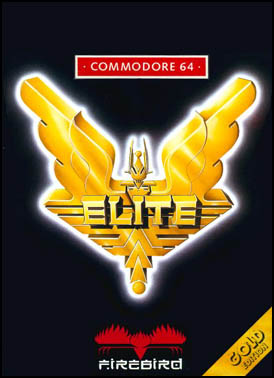
Disk label[edit | edit source]
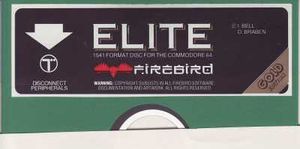
Cassette[edit | edit source]
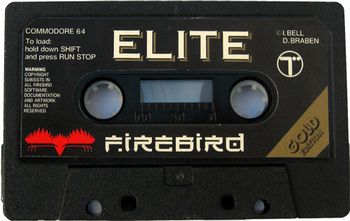
Advertisement[edit | edit source]
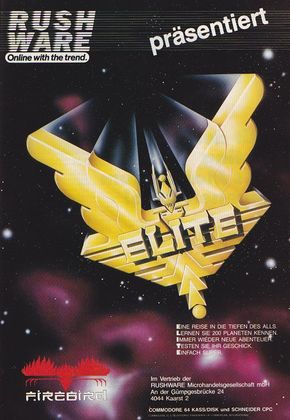 |
Award[edit | edit source]
- The game was awarded the British Golden Joystick Award in the category Best Original Game of the Year in 1984. The award referred to the BBC Micro and Acorn Electronic version which had been released a year earlier.
Trivia[edit | edit source]
In Elite an own pseudo random generator is used with a six bytes seed. The programmers of the Archmides version "ArcElit" (which were not Bell/Braben) specially integrated a rudimentary 6502 emulator so that on the ARM the same galaxies could be generated as on the BBC B and C64.
You cannot deny the creators a certain humor, as you can find some hints and allusions both in the game itself and in the documentation:
- The starting sequence resembles the starting sequence of a "Viper"- fighter ship in the TV series "Battlestar Galactica". It can be coincidence that the police spaceships in the game are also named "Viper" as almost all spaceship types carry names of snake species.
- The docking sequence follows the model of a similar scene in the movie "2001: A Space Odyssey"; a rectangular docking opening of a space station is also shown there. In the movie it is accompanied with "The Blue Danube" (Danube waltz) by Johann Strauss II (son). In the game the same melody is played when the docking computer is in operation.
- The "Trumbel" animal reminds one strongly of the "Tribbles" from two episodes of the TV series "Star Trek". The "Tribbles" also became a plague due to their unbelievable reproduction rate.
- In the manual the commander of a "Python"- spaceship named "Monty" is mentioned.
- Also the company "Whatt & Prittney" (instead of "Pratt & Whitney") is mentioned in the manual as manufacturer of gears.
- The first two ranks as a fighter are "harmless" and "mostly harmless". By a strange coincidence this corresponds exactly to the first and the revised entry in the travel guide "The Hitchhiker's Guide to the Galaxy" about the third planet of a small unregarded yellow sun far out at the uncharted backwaters of the unfashionable end of the western spiral arm of the galaxy. (see also: http://www.iancgbell.clara.net/elite/faq.htm#A23)
- In the English Version the trading good platinum is not named platinum but latinum (but not pressed with gold!).
- If especially many enemies were destroyed within a short time, the praising comment "Right on Commander!" appears.
- The name Jameson goes back to the Whisky brand with the same name, as David Braben revealed in 2012.
- Jameson wasn't all that important at the start, but has become so as he has become part of the Elite lore. The initial reason was I wanted a 7 letter commander name that would work as a filename on both the BBC micro and Acorn Atom. Ian and I discussed a few possible names. I liked Jameson as it is one of the best blended whiskys!
Source:http://www.reddit.com/r/IAmA/comments/15od2s/i_am_david_braben_cocreator_of_elite_creator_of/
- Jameson wasn't all that important at the start, but has become so as he has become part of the Elite lore. The initial reason was I wanted a 7 letter commander name that would work as a filename on both the BBC micro and Acorn Atom. Ian and I discussed a few possible names. I liked Jameson as it is one of the best blended whiskys!
Unofficial versions[edit | edit source]
- Plus/4: Two versions were made independently from each other and without commercial background. The earlier version is by Pigmysoft from 1988, the later one is from 1994 by Csory 1994 (they are both developers from Hungary).[2]
- C128: This is mainly a C64 version that is more a hack than a conversion to use certain hardware features of the C128. Apparently, the game profits from the higher clock rate of the 2 MHz mode here (which is dynamically used). [3]
Highscore[edit | edit source]
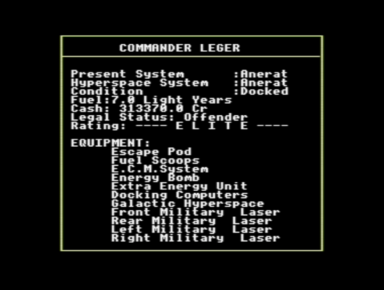
- Chris Leger - 313.370,0 credits - >6.400 kills "ELITE" (30.08.2021)
- Colt Seavers - 229.254,0 credits - >6.400 kills "ELITE" (20.08.2017)
- José - 106.006,4 credits - >6.400 kills "ELITE" (15.03.2004)
- Worf - 66.092,6 credits - >512 kills "dangerous" (25.02.2004)
- FXXS - 5.303,2 credits - >64 kills "above average" (25.05.2014)
- Equinoxe - 2.433,4 credits - >8 kills "relatively harmless" (31.08.2011)
- Sledgie - 153,5 credits - 3 kills (19.01.2004) ;-)
Links[edit | edit source]
| Wikipedia: Elite |
- C64Games.de - Game No. 594
 (here you find the manual (incl. novel, maps, solutions, tips, etc.) in
(here you find the manual (incl. novel, maps, solutions, tips, etc.) in 
- C64Games.de - Game No. 593

- C64Games.de - Game No. 3675
 /
/  (Elite 128, extended version, also for C64)
(Elite 128, extended version, also for C64) - Gamebase64.com - Game No. 2475

- Gamebase64.com - Game No. 2474

- Gamebase64.com - Game No. 2476
 /
/  (Elite 128, extended version, also for C64)
(Elite 128, extended version, also for C64) - Lemon64 - Game No. 818
- ready64 - Game No. 32

- TheLegacy entry no.4252
- Test Report No. 618 on Kultboy.com

- The SixtyFour Originals DataBase - Game No. 538
- ZZap64 test report
- C64endings
- CSDb
- Homepage by Ian Bell about Elite
- Editor for commander
- Links to C64Games forum entry "Highscore Elite"

- Documentation at x-speed with the novel 'Das Dunkle Rad'

- Elite - The New Kind - A clone of the BBC micro version of this game
- "Ooelite" - A fork of Elite First Encounters for Windows, Linux and Mac OS X
- Oolite Interactive Map (with routeplanner, seems to work also with Elite.)
- Elite 2 at GTW
References[edit | edit source]
| Wikipedia: The_Blue_Danube |
| Wikipedia: Battlestar_Galactica_(1978_TV_series) |
| Wikipedia: Star_Trek |
| Wikipedia: 2001:_A_Space_Odyssey_(film) |
| Wikipedia: Hitchhiker's_Guide_to_the_Galaxy |
Videos[edit | edit source]
- Video at YouTube (short excerpt)
- Video at YouTube (only music)
- Five back-to-back Thargoid encounters (Video on YouTube)
Sources[edit | edit source]
- ↑ The original Elite theme was composed by Aidan Bell and arranged by Chris Abbott

- ↑ Video at YouTube Lukozer Retro Game Review 414 - Elite Plus 4 - Commodore Plus/4
- ↑ Video at YouTube Lukozer Retro Game Review 413 - Elite 128 - Commodore 128
